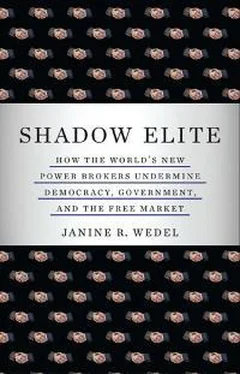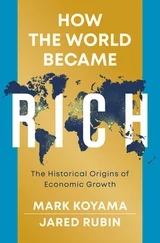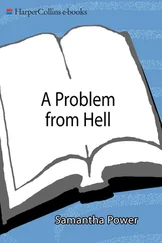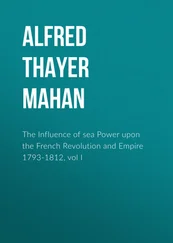The existing means of curbing the coincidences of interests and forms of power and influence that movers in the Harvard project, and Harvard University itself, forged seem impotent. Even exposure in the press proved of little effect. In the mid- to latter 1990s articles about the role of the U.S.-funded Harvard advisers in Russia’s economic reforms began to reveal their web of interconnections. But the Harvard players’ maze of high-powered network enfeebled the multiple investigations of their activities. 59
And there has been no dearth of inquiries. The various governmental and business investigations into the handling of U.S. assistance for Russian economic reforms entrusted to Harvard began as early as 1996. Although the GAO report published that year went only so far as to call USAID’s oversight over Harvard’s Russia project “lax,” its original draft report (a copy of which was given to me by GAO staff) was far more critical. 60
The U.S. government tried to penalize the Harvard players for their purported conflicts of interest and alleged (mis)use of government monies, but it was slow to act. In 1997 the Justice Department embarked on its investigation, and later sued Shleifer, Hay, and Harvard University on the grounds that they had conspired to defraud the government. But it was eight years before the case culminated, and that was merely with a negotiated settlement. The 2005 settlement required the university to pay fines to the U.S. government of $26.5 million, Shleifer to pay $2 million, and Hay between $1 and $2 million. The lawsuit against the same players brought by the American mutual funds firm was settled out of court. The civil suit brought against Hay over an alleged fraud and money-laundering scheme was apparently not resolved in his favor, although it seemed to do him little harm. At least one other investigation was initiated, then suspended. 61
While these probes were in process, Shleifer’s star was steadily rising. He consulted as an anticorruption expert and testified before a congressional committee on the same topic. No mention was made that Shleifer himself was the target of a government investigation. Shleifer, again as an expert on corruption, also published articles in reputable journals. Foreign Affairs printed his piece on the supposed success of Russian “reforms”—without mentioning his role in crafting them. In 1999 he was awarded the American Economic Association’s John Bates Clark Medal, a prestigious prize for the top economist under forty, with Summers’s fingerprints on the selection process. In 2003, the same association appointed him editor of its Journal of Economic Perspectives . Despite Harvard’s having to pay a record settlement, largely because of Shleifer’s activities, he has been (and remains) a full professor there. 62
The U.S. government and its investigators proved no match for Harvard University and its powerful network. To name one example, under pressure from GAO lawyers, themselves under pressure from Harvard’s lawyers, GAO staff were forced to dilute the strength of their report. Not only did Harvard do little to look into activities conducted in its name, but in 2001 the Harvard Corporation, with sole authority to hire and fire the Harvard president, tapped Summers to serve as president of the university, despite all the information on record about his entanglements. Only after Harvard settled the government lawsuit did Summers resign (in 2006) amid public relations troubles within and outside the university. In true flexian fashion, he landed well, as a university professor at Harvard, a part-time managing director of the investment and technology development firm D. E. Shaw & Co., and columnist for the Financial Times . He has since landed even more smoothly. While fallout from his unpopular performance as Harvard president may have kept him from being renamed treasury secretary and confirmed by Congress, he is now back in the saddle as a crucial economic adviser to President Obama. Not only did his Harvard and Russia track records not keep him from a White House post, his past advice and promotion of deregulation—which has come back to haunt the financial system of the United States, indeed the world—did not deter Obama from appointing him. 63
Hay, for his part, was employed between 2002 and 2005 as an associate in the London office of Cleary Gottlieb, a law firm, and today works for a real estate development company in Ukraine. Unlike Chubais, Sachs, and Shleifer, Hay never had a big media or academic profile. But his legal troubles don’t appear to have derailed his career. 64
For both Shleifer and Hay, these troubles have amounted to a mere slap on the wrist, albeit a costly one. Any damage to the reputation of Shleifer, the much better known of the two, seems to be inconsequential in the circles that matter. As Harry R. Lewis, professor and former dean at Harvard, opined in 2006, “Most of Shleifer’s economist colleagues [have] gathered around him supportively. . . . In fact, no one seems ashamed of this affair at all.” 65
While Shleifer and Hay had to pay settlements and legal fees, it is too late for the Russian people, who, instead of wise guidance, got a corrupt, vastly inequitable system. Shleifer’s defense in the Justice Department’s lawsuit is emblematic of flexians’ and flex nets’ evasion of responsibility: Although U.S. prosecutors charged that his investments violated federal conflict-of-interest regulations, defense lawyers maintained that he was a “mere consultant,” and thus not subject to these rules. Yet as director of the project, the buck stopped with him.
Harvard University, for its part, is not on record as having publicly apologized or publicly acknowledged responsibility, while paying millions of dollars in fees for legal settlement.

THE GRAND PLANS never worked out, reform is dead, and even the idea of reform has been badly battered. But the new institutional forms blending official and private power that the players fashioned are alive and well.
To the extent that the Chubais-Harvard players were vulnerable to sanction from legal and media quarters, it was almost invariably due to their alleged conflicts of interest, not the coincidences of interest they structured for themselves as they fused official and private power. Yet it is precisely their coincidences of interest that afforded them vast power and influence, beyond the input of citizens and the reach of monitors. Today it seems that their coincidences of interest, and the new forms of governing that they escort, have ricocheted back to the United States.

CHAPTER SIX
The Commandeers
RICHARD PERLE, PAUL WOLFOWITZ, DOUGLAS FEITH. IT SEEMS THE world has moved on and left these neoconservatives—prime movers behind the war in Iraq—in the dust. The flex net that I call the Neocon core, a tight-knit dozen or so key players clustered around Richard Perle, are out of power and favor with the Obama administration. But in their longtime quest to remake American foreign policy according to their own vision, they have put an indelible stamp on the shape of the Middle East. And in doing so, they have pioneered ways of engaging in governing and policy in the United States—forging new fusions of official and private power—that are far from the eye of publics and reach of government monitors, yet have gained a certain acceptability. Their policy endeavors have not always met with success, but in their means of exercising power and influence, they have consistently been one step ahead of transformational global and American developments under way. That is why, even though they may be largely out of favor with the current administration, the story of their profound impact is such an important tale to tell. As one observer close to the Neocon core put it to me, “Where they were successful, they out bureau-cratted the bureaucracy.”
Читать дальше














